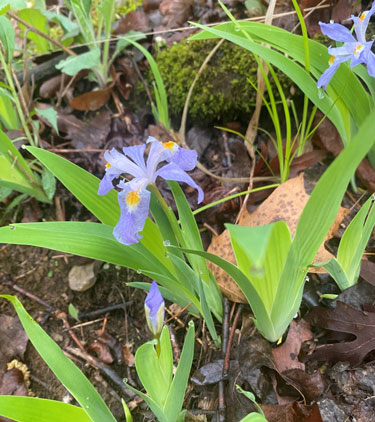Resource Library
Plant of the Week: Crested irises in Arkansas | Native iris in Arkansas
The University of Arkansas System Division of Agriculture does not promote, support or recommend plants featured in "Plant of the Week." Please consult your local Extension office for plants suitable for your region.
Plant of the Week
Crested Iris
Latin: Iris cristata
 This morning as I sat on my deck - cup of coffee in hand - surveying my fading crop
of azalea blooms, I was struck by the elusive nature of gardens. Here today, gone
tomorrow.
This morning as I sat on my deck - cup of coffee in hand - surveying my fading crop
of azalea blooms, I was struck by the elusive nature of gardens. Here today, gone
tomorrow.
This fleeting nature is borne out in an assignment in one of my classes where students are required to write a paper on some person important in horticultural history. Most of the students, because references are required, choose some famous garden designer. Almost invariably they state somewhere in their report something like "of the 300 gardens designed, only a single example remains of their work."
Not only are the flowers of little plants like the crested iris fleeting, but so is the very garden in which we plant them.
The crested iris is one of the woodland wildflowers of the eastern deciduous forest where it is found as far to the northeast as Maryland and as far south as Georgia and west to the edge of the prairie.
It typically grows on sloping ground facing east or north, often in fairly deep shade. It has slender, surface dwelling rhizomes that swell near the fan of leaves which are shaped like a knife blade and grow about 6 inches long. The light blue flowers are held above the foliage with a typical iris-like bloom, but in miniature. The blooms are produced in April with the bloom display lasting for about two weeks.
The type of garden we choose to build affects the temporal nature of the display we create. Formal plantings, such as the parterre displays of the French or the patchwork displays of the Victorian era, pass from garden to weed patch in a single season without the hand of the caring gardener.
Perhaps the Japanese garden, with its strong reliance on stone and sparse plantings, is the most lasting style of design without continual intervention, but even it will loose form and definition without the touch of the gardener.
Some might contend that a garden of native plants will have permanence, but natives too are quickly lost without the gardener keeping the relentless creep of nature at bay. I developed a rock garden a few years ago with a heavy reliance on native plants. But within a year of moving on, the garden changed from what I considered a beautiful planting to a barren pile of rocks when the new owners failed to take an active interest in the garden.
Gardeners, it seems to me, pursue their passion from some inner need, yet fully aware that their toil will have a transitory nature. Perhaps this is as it should be. We’re born, we garden because we have to, and then we die.
The British, where gardening is a national passion, have developed the National Trust which preserves and maintains gardens in perpetuity. Even there, it is the large estates that are preserved, not the small gardens of countless ordinary folk.
Fleeting though its flower display may be, the crested iris is still a worthy garden plant.
It’s foliage makes it a beautiful groundcover in the shade garden. It does especially well at the base of large trees where it will colonize an area within a few years. Give it a well drained site rich in organic matter, and it should prosper for years. Division can be done at almost any time, but late summer or early fall is probably preferable.
By: Gerald Klingaman, retired
Extension Horticulturist - Ornamentals